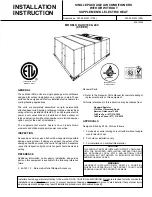
Work method when reinforcing the heat insulation of on-site piping
Fig. B
Slit of heat insulating material
facing upward
Covered gas
pipe (heat
insulation
strengthened)
Heat insulating material
(locally purchased)
Small exposed part
of copper pipe is desirable.
Fit tightly
(purpose is to cover the sealant)
Binding material
Flare connection
To indoor unit
Heat insulation reinforcement material
(locally purchased)
Condition
Contents
Countermeasures (Reference)
When using an
external duct.
When using an external duct to take in new fresh air, etc.,
condensation may form on the surface of the duct due to
the effect of the outside air temperature and the humidity
inside the ceiling.
Always perform heat insulation
processing.
(Heat insulating material: Glass wool
25-mm [1-in] thick or more.)
When the
remote
controller
installation site
is bad.
If the cold or warm air blown out from the air conditioner
directly contacts the thermostat section of the remote
controller, the outlet temperature of the air conditioner may
be sensed and room temperature control will be different
from the room temperature, and “not cooled” or “not
heated” or other trouble may occur.
In addition, there is the possibility that the same kind of
trouble may also occur when the remote controller is
effected by direct sunlight.
1. Install the remote controller
where it will not be directly
exposed to the cold or hot air.
2. Install the remote controller
where it will not be directly
exposed to sunlight or strong
lighting.
When
installation
environment is
quiet.
When the wall mounted type was installed in a bedroom,
living room, or other quiet place, the sound of the
refrigerant flow may be sensed as noise and must be
taken into account.
1. Plan installation of a model with
external expansion valve.
2. Plan installation of a branch box
farther from indoor unit.
3. Plan installation using another
air conditioner.
When installing
duct type in
ceiling chamber
system.
In the case of the ceiling chamber system (duct is not
installed at indoor unit inlet side and room air is sucked
into the indoor unit through the inside of the ceiling), the
thermistor inside the indoor unit may not correctly detect
the room temperature.
• Heating operation: Room is not heated because the
indoor unit is easily turned off by the thermostat.
• Cooling operation: Room is too cold because the indoor
unit is difficult to turn off by the thermostat.
Replace the indoor unit thermistor
with optional Remote sensor unit,
and install the sensor where the
room temperature can be correctly
detected.
When the outlet
air is sucked in
at duct type.
Cooling operation does not cool the room and heating
operation does not heat the room because the short
circuited indoor unit is not turned on by the thermostat.
1. Reconsider the ventilation port
construction.
2. Replace the indoor unit
thermistor with optional Remote
sensor unit, and install the
sensor where the room
temperature can be correctly
detected.
When using the
wireless remote
controller.
Signals may not be received when using it in a room
illuminated by an inverter fluorescent lamp.
Turn on the fluorescent lamp and
check if the indoor unit receives the
signals from the remote controller. If
the indoor unit does not receive the
signals, consult an authorized
service personnel.
When installing
the inverter
type.
It may generate noise in TV sets, stereos and PCs.
The inverter type should be installed
at a sufficient distance from these
equipments.
- 173 -
17-2. Points to remember when installing
17. Indoor unit installation precautions
MULTI TYPE
2, 3, 4 ROOMS TYPE
MULTI TYPE
2, 3, 4 ROOMS TYPE
















































